Related Research Articles

Constantinople became the capital of the Roman Empire during the reign of Constantine the Great in 330. Following the collapse of the Western Roman Empire in the late 5th century, Constantinople remained the capital of the Eastern Roman Empire, the Latin Empire (1204–1261), and the Ottoman Empire (1453–1922). Following the Turkish War of Independence, the Turkish capital then moved to Ankara. Officially renamed Istanbul in 1930, the city is today the largest city in Europe, straddling the Bosporus strait and lying in both Europe and Asia, and the financial centre of Turkey.

Isidore of Miletus was one of the two main Byzantine Greek mathematician, physicist and architects that Emperor Justinian I commissioned to design the cathedral Hagia Sophia in Constantinople from 532 to 537. He was born c. 475 AD. The creation of an important compilation of Archimedes' works has been attributed to him. The spurious Book XV from Euclid's Elements has been partly attributed to Isidore of Miletus.

Epcot, stylized in all uppercase as EPCOT, is a theme park at the Walt Disney World Resort in Bay Lake, Florida. It is owned and operated by The Walt Disney Company through its Experiences division. Inspired by an unrealized concept of the same name developed by Walt Disney, the park opened on October 1, 1982, as EPCOT Center, and was the second of four theme parks built at Walt Disney World. The park spans 305 acres, more than twice the size of Magic Kingdom. Often referred to as a "permanent world's fair", Epcot is dedicated to the celebration of human achievement, particularly technological innovation and international culture.

Cyzicus was an ancient Greek town in Mysia in Anatolia in the current Balıkesir Province of Turkey. It was located on the shoreward side of the present Kapıdağ Peninsula, a tombolo which is said to have originally been an island in the Sea of Marmara only to be connected to the mainland in historic times either by artificial means or an earthquake.
Hippodamus of Miletus was an ancient Greek architect, urban planner, physician, mathematician, meteorologist and philosopher, who is considered to be "the father of European urban planning", and the namesake of the "Hippodamian plan" of city layout, although rectangular city plans were in use by the ancient Greeks as early as the 8th c. BC.

The Experimental Prototype Community of Tomorrow, shortened to EPCOT or E.P.C.O.T., was an unfinished concept for a planned community, intended to sit on a swath of undeveloped land near Orlando, Florida. It was created by Walt Disney in collaboration with the designers at Walt Disney Imagineering in the 1960s. Based on ideas stemming from modernism and futurism, and inspired by architectural literature about city planning, Disney intended EPCOT to be a utopian autocratic company town. One of the primary stated aims of EPCOT was to replace urban sprawl as the organizing force of community planning in the United States in the 1960s. Disney intended EPCOT to be a real city, and it was planned to feature commercial, residential, industrial, and recreational centers, connected by a mass multimodal transportation system, that would, he said, "Never cease to be a living blueprint of the future".
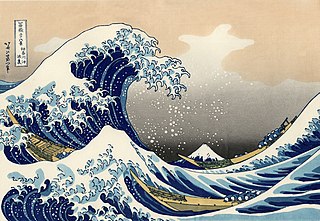
The Edo period, also known as the Tokugawa period, is the period between 1603 and 1868 in the history of Japan, when Japan was under the rule of the Tokugawa shogunate and the country's 300 regional daimyo. Emerging from the chaos of the Sengoku period, the Edo period was characterized by economic growth, strict social order, isolationist foreign policies, a stable population, perpetual peace, and popular enjoyment of arts and culture, colloquially referred to as Ōedo.

Rumelihisarı or Boğazkesen Fortress is a medieval Ottoman fortress located in Istanbul, Turkey, on a series of hills on the European banks of the Bosphorus. The fortress also lends its name to the immediate neighborhood around it in the city's Sarıyer district.

Constantinos A. Doxiadis, often cited as C. A. Doxiadis, was a Greek architect and urban planner. During the 1960s, he was the lead architect and planner of Islamabad, which was to serve as the new capital city of Pakistan. He was later known as the father of ekistics, which concerns the multi-aspect science of human settlements.
Raymond "Ray"L. Watson was the former president of the Irvine Company, and served as chief planner during the 1960s and 1970s. He was also chairman of Walt Disney Productions from 1983 to 1984, and served on the Disney board from 1972 until March 2004.
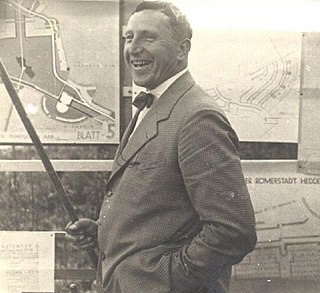
Ernst Georg May was a German architect and city planner.
Val d'Europe is the easternmost sector of the new town of Marne-la-Vallée, located around 35 km (22 mi) to the east of Paris, France. It was built as part of a public-private partnership between The Walt Disney Company and the French state, based on a convention signed in 1987. It is bordered by the Marne river to the north, the A4 motorway to the south, and is served by the RER A suburban train line as well as the LGV Interconnexion Est high-speed train line.
Charles Luckman was an American businessman, property developer, and architect known for designing landmark buildings in the United States such as the Theme Building, Prudential Tower, Madison Square Garden, and The Forum. He was named the "Boy Wonder of American Business" by Time magazine when president of the Pepsodent toothpaste company in 1939. Through acquisition, he later became president of Lever Brothers. Luckman would later collaborate with William Pereira, in which the two would form their architectural firm, Pereira & Luckman, in 1950. Pereira & Luckman would later dissolve by 1958, parting ways for both himself and Pereira. Luckman would continue successfully with his own firm, Charles Luckman Associates. Luckman retired from the firm, although he would still be present.
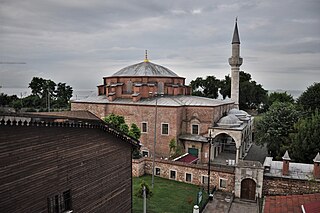
The Little Hagia Sophia mosque, formerly the Church of Saints Sergius and Bacchus, is a former Greek Orthodox church dedicated to Saints Sergius and Bacchus in Constantinople, built between 532 and 536, and converted into a mosque during the Ottoman Empire.

The Column of Constantine is a monumental column commemorating the dedication of Constantinople by Roman emperor Constantine the Great on 11 May 330 AD. Completed c. 328 AD, it is the oldest Constantinian monument to survive in Istanbul. The column stood in the centre of the Forum of Constantine, on the second-highest of the seven hills of Nova Roma, and was midway along the Mese odos, the ancient city's main thoroughfare.

The architecture of Copenhagen in Denmark is characterised by a wide variety of styles, progressing through Christian IV's early 17th century landmarks and the elegant 17th century mansions and palaces of Frederiksstaden, to the late 19th century residential boroughs and cultural institutions to the modernistic contribution of the 20th century such as Arne Jacobsen's National Bank and SAS Royal Hotel.
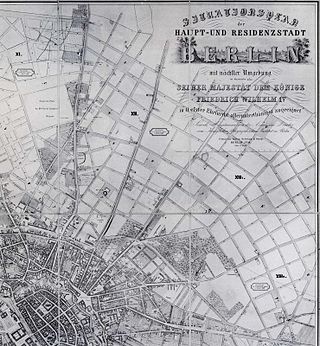
The Hobrecht-Plan is the binding land-use plan for Berlin in the 19th century. It is named after its main editor, James Hobrecht (1825–1902), who served for the royal Prussian urban planning police ("Baupolizei").
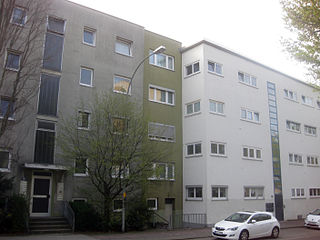
After World War I, a new planned satellite town was constructed at Römerstadt, outside Frankfurt in Germany, with the intention to improve housing and living conditions. The lead architect was Ernst May and the design philosophy bore similarities with the English Garden city movement.

Urban planning, also known as town planning, city planning, regional planning, or rural planning in specific contexts, is a technical and political process that is focused on the development and design of land use and the built environment, including air, water, and the infrastructure passing into and out of urban areas, such as transportation, communications, and distribution networks and their accessibility. Traditionally, urban planning followed a top-down approach in master planning the physical layout of human settlements. The primary concern was the public welfare, which included considerations of efficiency, sanitation, protection and use of the environment, as well as effects of the master plans on the social and economic activities. Over time, urban planning has adopted a focus on the social and environmental bottom lines that focus on planning as a tool to improve the health and well-being of people while maintaining sustainability standards. Sustainable development was added as one of the main goals of all planning endeavors in the late 20th century when the detrimental economic and the environmental impacts of the previous models of planning had become apparent. Similarly, in the early 21st century, Jane Jacobs's writings on legal and political perspectives to emphasize the interests of residents, businesses and communities effectively influenced urban planners to take into broader consideration of resident experiences and needs while planning.
Storyliving by Disney is a business venture and brand of The Walt Disney Company announced on February 16, 2022, to collaboratively develop master-planned communities that utilize Disney Imagineering and are staffed by Disney cast members. It operates under the company's Disney Living Development, Inc. subsidiary. Cotino, in Rancho Mirage, California, was the first Storyliving by Disney community chosen for development, where ground breaking took place in April 2022. In December 2023, plans were announced for a second such community, named Asteria, in Pittsboro, North Carolina.
References
- ↑ Akira, Naito. "From Old Edo to Modern Tokyo: 400 Years". NIPPONIA. Retrieved 7 January 2020.